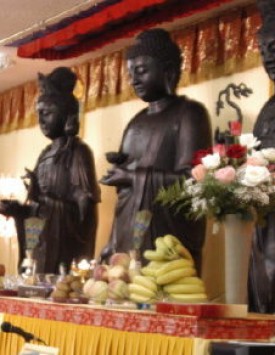[Chinese: 大勢至菩薩 Dàshìzhì Púsà or 金剛手菩薩 Jīngāngshǒu Móhēs; Japanese: Daiseishi or Kongōshu; Korean: 대세지Daeseji or 금강수; Vietnamese: Đại Thế Chí or Kim cương thủ;Tibetan: ཕྱག་ན་རྡོ་རྗེ་ Chakna Dorjé; Sanskrit: “Vajra in [his] hand”), the Bodhisattva of Great Strength or Skillful Means and a peaceful emanation of Vajrapani Bodhisattva is a mahāsattva representing the power of wisdom, often depicted in a trinity with Amitābha Buddha and Avalokiteśvara Bohisattva, especially in Pure Land Buddhism. His name literally means “arrival of the great strength as an elephant”. Mahāsthāmaprāpta (Vajrapani) is one of the Eight Great Bodhisattvas in Mahāyāna Buddhism, along with Mañjuśrī, Samantabhadra, Avalokiteśvara, Akasagarbha, Kṣitigarbha, Maitreya and Sarvanivarana-Vishkambhin.
Vajrapani is one of the earliest-appearing bodhisattvas in Mahayana Buddhism. He is the protector and guide of Gautama Buddha and rose to symbolize the Buddha’s power. Vajrapani is extensively represented in Buddhist iconography as one of the three protective deities surrounding the Buddha. Each of them symbolizes one of the Buddha’s virtues: Mañjuśrī manifests all the Buddhas’ wisdom, Avalokiteśvara manifests all the Buddhas’ compassion, and Vajrapāṇi manifests all the Buddhas’ power as well as the power of all five tathāgatas. Vajrapāṇi is one of the earliest dharmapalas and the only Buddhist deity to be mentioned in the Pāli Canon as well as be worshiped in the Shaolin Monastery. In Tibetan Buddhism and in Pure Land Buddhism, he is known as Mahasthamaprapta and forms a triad with Amitābha and Avalokiteśvara. Manifestations of Vajrapāṇi can also be found in many Buddhist temples in Japan as dharma protectors called the Niō or “Two Kings”. Vajrapani is also associated with Acala, who is venerated as Fudo-Myō in Japan, where he is serenaded as the holder of the vajra.
This Bodhisattva’s birthday is celebrated on the thirteenth day of the seventh lunar month.

